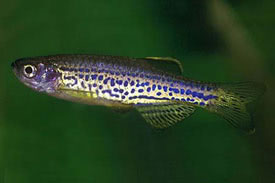
 Magyarul / Hungarian
Magyarul / Hungarian


- Scientific name: Danio rerio var. frankei
- Synonyms: Barilius rerio, Brachydanio frankei, Brachydanio rerio, Cyprinus chapalio, Cyprinus rerio, Danio frankei, Danio lineatus, Nuria rerio, Perilampus striatus
- Common name: Leopard danio
- Group: Cyprinids
- Habitat: Asia; India
- Size: 5 cm
- Biotope: Inhabits in clear freshwater streams of South East Asia
- Social behavior: An active schooling species which can be kept in almost any community tank. Do not combine the Leopard Danio with species that are frightened with constant movement. The Leopard Danio forms pairs, and will often not spawn with different partners.
- Diet: Flakes, live, Drosophila, other insects, insect larvae, crustaceans; occasionally algae.
- Breeding: Easy
- Tank: Minimum 50 litres
- Population: 8 fish for 80 litres
- Decoration: The tank should have large, open swimming areas and a tight-fitting cover. A substrate of coarse gravel or pebbles is recommended. Use planting along the sides and back of the tank. This species is a jumper-so cover the tank well.
- Temperature: 23-27 °C
- pH: 6,8-7,2
- Hardness: 5,6-11,2 NK°
- Lifespan: 4 years
Description: An elongated fish with an appearance virtually identical to Danio rerio. The only difference is the coloration, with this "species" having a brownish back and a brownish-white body coloration. Instead of stripes, many small, blue spots are present. The fins retain the same pattern. Females are plumper when mature.
For breeding use warmer water with a temperature from 75-79°F (24-26°C). Use a tank with a water level of four to six inches deep, with heavy planting and a substrate of marbles. Condition the pair with insect larvae and Brine Shrimp. Add the female to the tank first, with the male being added 12-24 hours later. The pair usually will spawn with the coming of morning sunlight. 400-500 eggs are scattered on plants. The pair can be fed on white worms to keep them from consuming their spawn. After spawning is complete, remove the pair. The fry hatch in two days and are free-swimming after 5-7 days. Start feeding with paramecia, and a couple days later with powdered dry foods.



























